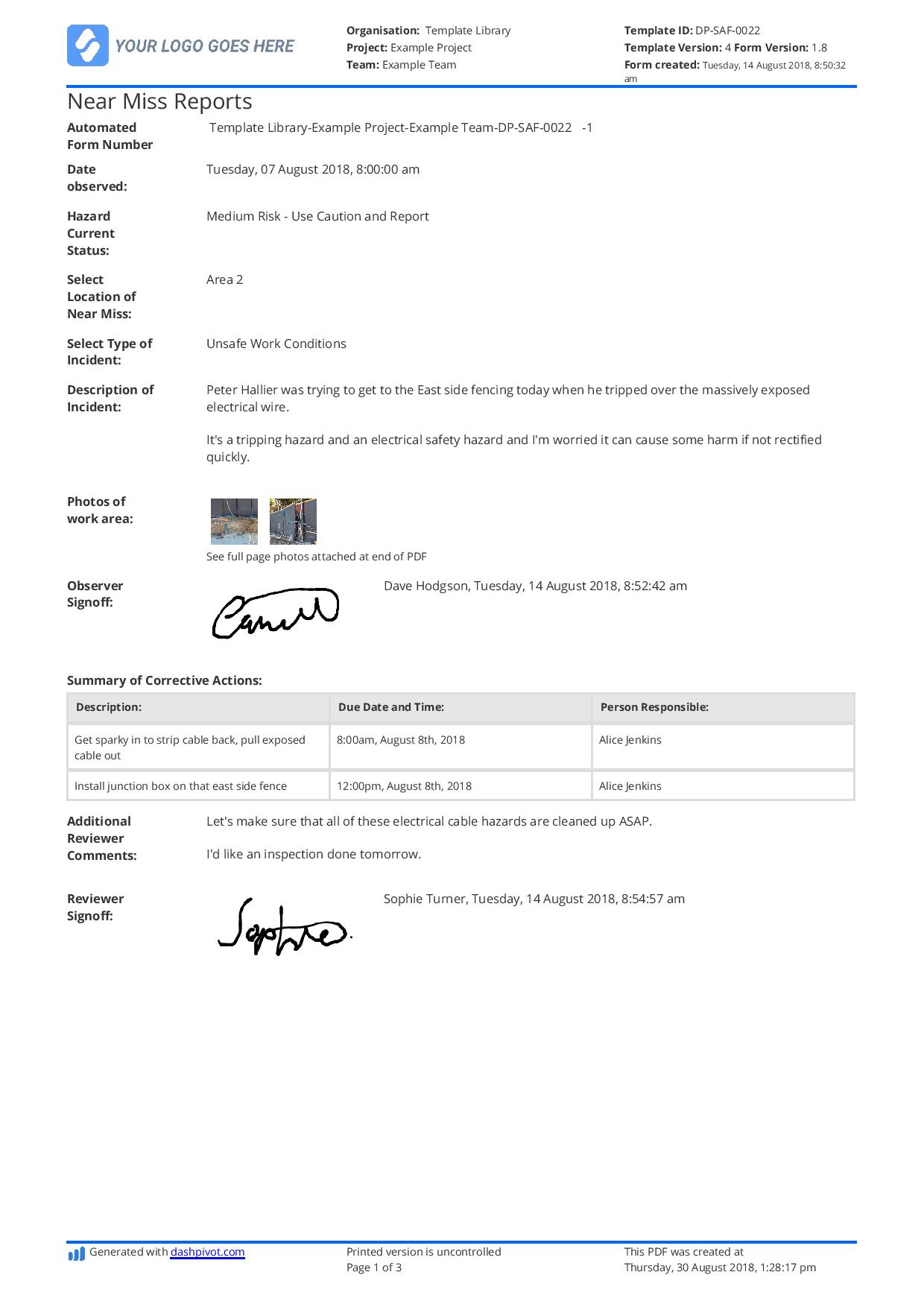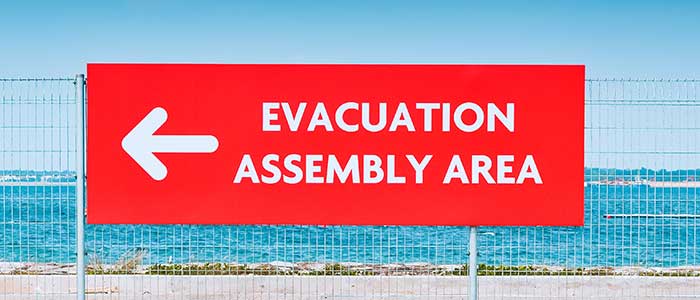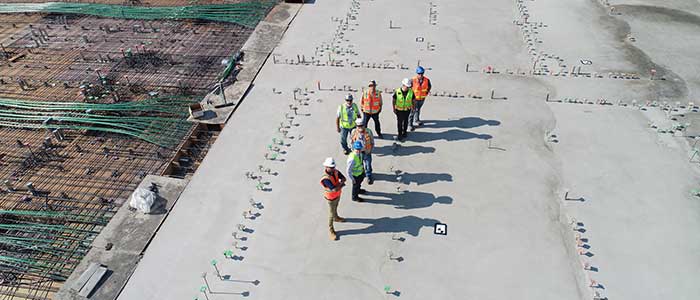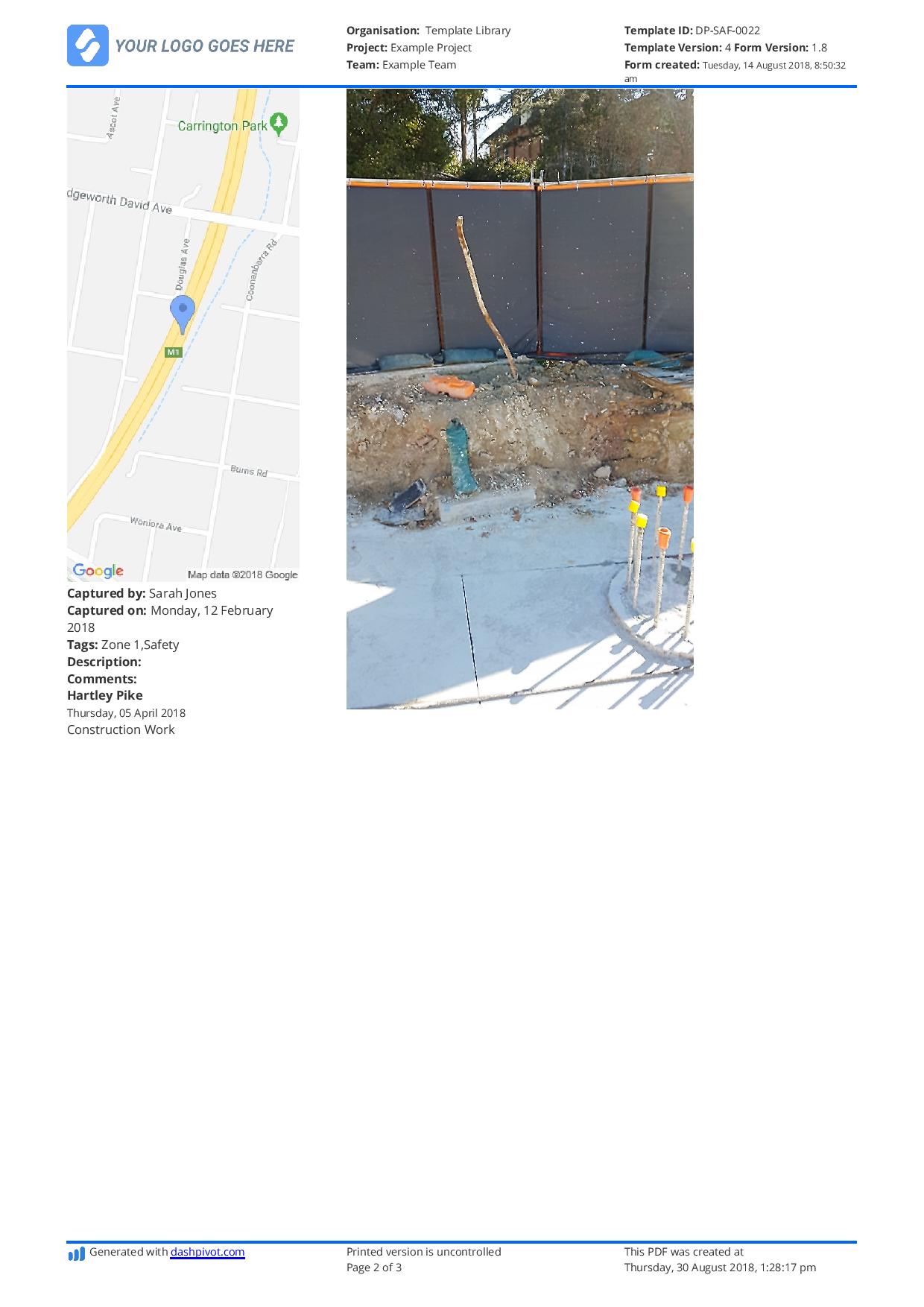Dashpivot article page – Near Miss Report Examples in Construction
Near Miss Report examples in Construction
In this article, you'll see a number of near miss report examples from the construction industry, as well as find some helpful tips and resources about near misses and safety.

What is a near miss in the context of construction?
In the context of construction, near misses could be about equipment malfunctions, slips, trips, falling objects, and many more happening in a construction site. They’re similar to a warning sign, indicating that there is a potential hazard. In this article, we'll cover the main near miss report examples in construction, and explain what you need to know about near misses in the context of these examples more broadly.
Near misses in construction sites are common occurrences because it’s a high-risk nature type of industry. The construction industry is one of those industries where it shouldn't be necessary to ask why it is important to report on near misses.
It’s an extremely dynamic environment that involves a lot of fast-paced operations in underground and elevated work areas, there is heavy machinery being operated, and there may even be hazardous materials on site. Construction sites have multiple workforces involved and it’s a dangerous site for employees, that’s why safety practices and awareness culture are particularly exercised on site.
The near misses in the context of construction often occur in common poor site conditions like cluttered workspaces, poorly maintained equipment, and insufficient hazard control.
If the workplace does not practice safety practices, there will be near misses occurring and they may even go unreported. It’s important to regularly update the safety protocols and company policies enforced, and promote an awareness and reporting culture in the workplace.
With the construction industry dealing with different types of workforces, it’s important to conduct safety and awareness training regularly, review the safety protocols of all contractors, inform all contractors that safety should be prioritised, and all construction managers and safety officers should foster a no-blame reporting culture of near misses.
What are Some Near Miss Report Examples in Construction?
Classifying the potential near misses in the construction industry helps the organisation understand the possible causes and trends, and develop interventions to improve workplace safety. Below are some of the main near miss report examples in construction.
Falls From Heights
Near misses from falls from heights involve workers using scaffolds, ladders, or any elevated platform, or objects falling on workers or construction property.
Falling Objects
Near misses from falling objects involve items like materials, tools, or debris falling on workers or construction property.
Slips and Trips
Near misses from slips, trips, and falls from the same level could be slipping on wet (or icy) or greasy surfaces, or workers losing footing by tripping on uneven surfaces, materials, or wire cords.
Equipment/Machinery Failure Near Miss Examples in Construction
Near misses involving equipment or machinery failure could be malfunctions in heavy equipment including cranes and hoists, or workers misusing the operation of the machinery and tools, or “close calls” where workers are almost hit by moving machinery or vehicles.
Electrical Hazards and Fire Risks
Near misses involving electrical hazards are workers making contact with live wires or even with faulty or sparking equipment.
Hazardous Substances
Near misses involving hazardous substances are chemical spills or leaks like fuel or paint, and workers being exposed to gases, fumes, or dust.
Structural Failure
Near misses involving structural failure are unstable materials shifting and almost hitting on workers caused by weak formwork and structural elements.
Confined Space Hazards
Near misses in confined space hazards involve lacking oxygen in closed spaces or having toxic gases around the air. Another instance would be when during an evacuation, workers are almost trapped or there is a delay in the evacuation in confined spaces.
Excavation and Trenching
Near misses in excavation and trenching areas involve partial collapsing of inner walls, unstable edges while excavating, or heavy equipment operating too close at unstable edges almost causing collapse.
Natural Hazards Near Miss Examples
Near misses caused by natural hazards are also common like strong winds, heavy rain, extreme heat, landslides, flooding, and other natural causes beyond the control of the organisation.
See a Construction Near Miss Report Example
Below is a near miss report example from the construction industry that provides you with deeper context about what a real near miss report looks like.

Document Near Miss Report Examples in Construction using electronic forms
How do Near Misses Differ From Accidents or Incidents, and are the Examples the Same?
It’s simple to differentiate whether an occurrence is a near miss or an accident. Distinction matters because near misses emphasise the possible or potential dangers from an ‘almost accident’, while accidents and incidents require reactive measures and damage control from the damage that had been done. Near misses indicate a high significant risk but accidents or incidents indicate damages that require repair or medical attention.
Near misses serve as a warning while accidents or incidents cause disruption in operations. Near misses may often go unreported because no actual harm was done while accidents or incidents are always reported because of the obvious damage and harm.
Even though near misses may not cause harm towards employees or damages to properties, it’s still essential to report for prevention.
Knowing the differences can help workers and employees determine the type of occurrence and correctly input in the reports. Consequently, organisations can properly organise the reports and determine the preventive measures appropriate for the near miss. Solutions for actual accidents or incidents are different from near misses’ because it involves damage control and possibly dealing with insurances if it involves lives.
Can Miscommunication Between Workers and Procedural Errors Lead to Near Misses?
Oftentimes miscommunication between workers can cause near misses. It could be because of unclear instructions from managers or supervisors, wrong assumptions regarding tasks, or language barriers.
It’s essential for supervisors to clarify the instructions to workers prior to starting the actual work, communicate the potential hazards in the working area, or communicate the radio and signal commands during equipment operation.
Procedural errors can also create unsafe conditions and situations that lead to near misses. Not following the company protocols and the proper procedures for dangerous operations may cause near misses.
Although luckily near misses don’t cause any harm to individuals, it’s still essential that the management and workers are aligned with the correct procedures in the workplace. Workers on site may use the equipment incorrectly, operate but not following the safety protocols, or bypass the lockout/tagout procedure.
The workplace may misinterpret a sequence of tasks in the workplace, or may possibly omit certain steps. Procedural errors mean the deviation of employees, workers, and management from the standard operating procedures of the company, and poorly defined procedures by the management. It’s essential to regularly review SOPs, conduct inspections and safety maintenance works, or before performing procedures, workers must run through a checklist to ensure the steps are followed correctly.
What information should be included in a near miss report for construction?
Construction sites have large and wide working areas, maybe even with multiple floors. So aside from the typical contents of a near miss report, for the reports in the construction industry, it should include visuals, photos, diagrams, and sketches.
The visuals provide proper context of the site or area where the near miss occurred. Photos can clearly show the hazards like unstable scaffolding, uneven surfaces, broken equipment, loose cables, and many more. These help the management and safety officers have a visual and clear understanding why the near misses happened.
How Can Digital Tools Streamline Near Miss Reporting in Construction?
Digital tools being used for near miss reporting streamlines the entire reporting process which makes it easier and faster for workers on site to send reports. Using a tool like Dashpivot, supervisors and safety officers can have real-time access to the reports and collaborate remotely.
Reports are safe and secured in a centralised database with layered permissions that only allow certain individuals to edit the reports to avoid accidental edits or deletion.
Dashpivot makes use of easy to use features with drag and drop capabilities like tables, pre filled text boxes, formula sections, and many more. You and your team can conveniently create a standard near miss report form for everyone to use and fill out. Attach photos for visual evidence and include GPS, mark-ups, and notes.

Hazard Report template
Document and report hazards quickly and thoroughly to keep everyone safe.

Safety Improvement Plan template
Create coherent, actionable and professional safety plans using this proven framework.

Safety Toolbox Talk template
This toolbox talk template is quick and easy to complete and signoff on site, and keeps all of your toolbox talks neatly organised and professional.

